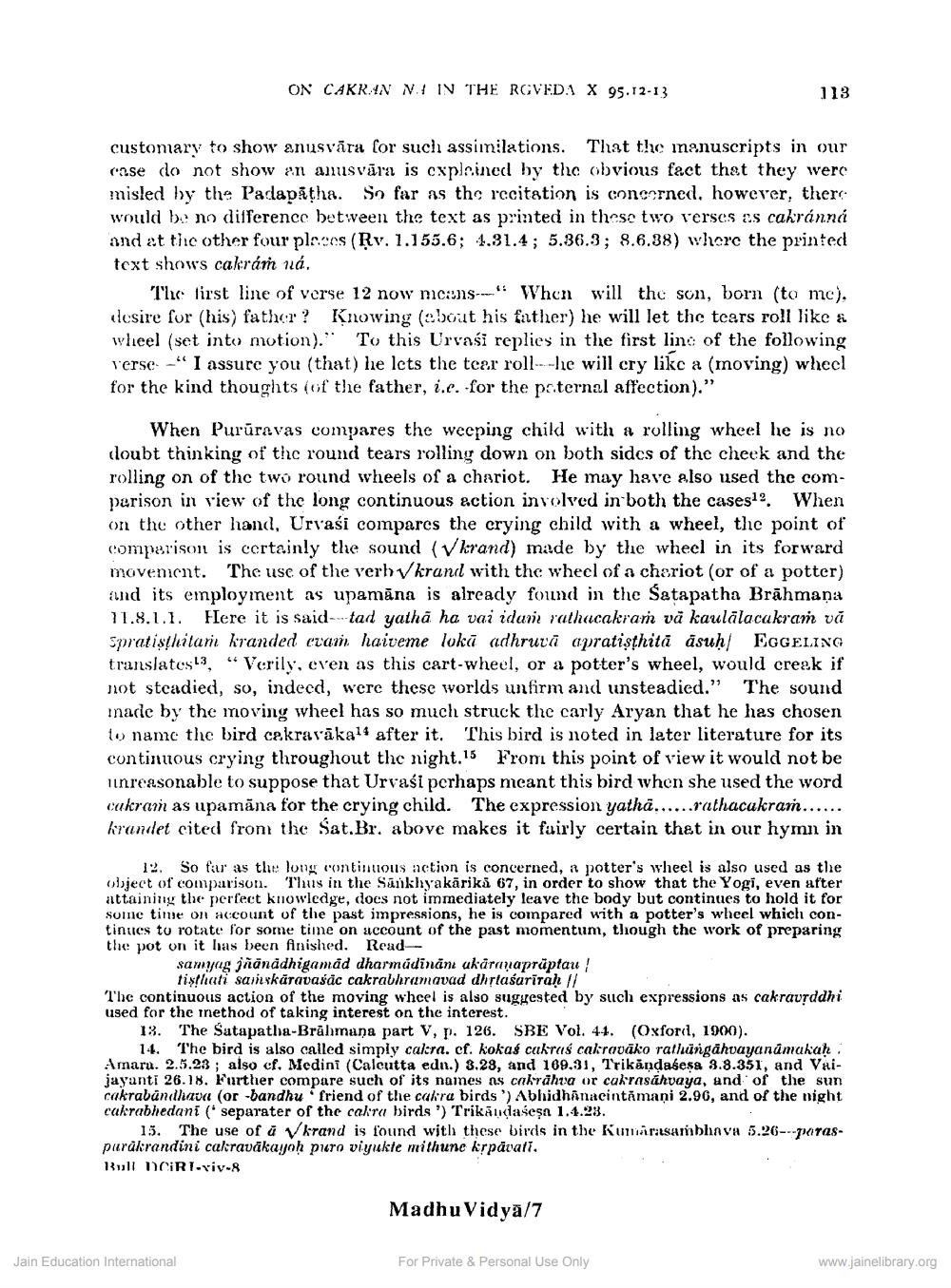________________
ON CAKRAN NA IN THE RGVEDA X 95.12-13
customary to show anusvara for such assimilations. That the manuscripts in our case do not show an anusvara is explained by the obvious fact that they were misled by the Padapatha. So far as the recitation is concerned, however, there would be no difference between the text as printed in these two verses es cakránná and at the other four places (Rv. 1.155.6; 4.31.4; 5.36.3; 8.6.38) where the printed text shows cakrám ná.
The first line of verse 12 now means When will the son, born (to me). desire for (his) father? Knowing (about his father) he will let the tears roll like & wheel (set into motion)." To this Urvast replies in the first line of the following verse" I assure you (that) he lets the tear roll--he will cry like a (moving) wheel for the kind thoughts (of the father, i.e. for the paternal affection)."
113
When Pururavas compares the weeping child with a rolling wheel he is no doubt thinking of the round tears rolling down on both sides of the cheek and the rolling on of the two round wheels of a chariot. He may have also used the comparison in view of the long continuous action involved in both the cases11. When on the other hand, Urvasi compares the crying child with a wheel, the point of comparison is certainly the sound (Vkrand) made by the wheel in its forward. movement. The use of the verby/krand with the wheel of a chariot (or of a potter) and its employment as upamana is already found in the Satapatha Brahmana 11.8.1.1. Here it is said tad yatha ha vai idam rathacakram vā kaulalacakram vā Spratisthitam kranded evan haiveme loka adhruva apratisthita asub EGGELING translates", "Verily, even as this cart-wheel, or a potter's wheel, would creak if not steadied, so, indeed, were these worlds unfirm and unsteadied." The sound nade by the moving wheel has so much struck the early Aryan that he has chosen to name the bird cakravāka1 after it. This bird is noted in later literature for its continuous crying throughout the night.15 From this point of view it would not be unreasonable to suppose that Urvasi perhaps meant this bird when she used the word cakram as upamana for the crying child. The expression yatha......rathacakram....... krandet cited from the Sat.Br. above makes it fairly certain that in our hymn in
12. So far as the long continuous action is concerned, a potter's wheel is also used as the object of comparison. Thus in the Sankhyakarika 67, in order to show that the Yogi, even after attaining the perfect knowledge, does not immediately leave the body but continues to hold it for some time on account of the past impressions, he is compared with a potter's wheel which continues to rotate for some time on account of the past momentum, though the work of preparing the pot on it has been finished. Read
samyag jñānādhigamad dharmādīnām akāraṇaprāptau! tisthati samskäravasac cakrabhramavad dhṛtasariraḥ ||
The continuous action of the moving wheel is also suggested by such expressions as cakravṛddhi used for the method of taking interest on the interest.
13. The Satapatha-Brahmana part V, p. 126. SBE Vol. 44. (Oxford, 1900).
Jain Education International
14. The bird is also called simply cakra. cf. kokaś cakras cakravāko rathāngāhvayanamakaḥ Amara. 2.5.23; also cf. Medini (Calcutta edn.) 3.28, and 169.31, Trikanḍaśesa 3.8.351, and Vaijayanti 26.18. Further compare such of its names as cakrahva or cakrasahvaya, and of the sun cakrabandhava (or bandhu friend of the cakra birds') Abhidhanacintamani 2.96, and of the night cakrabhedani ( separater of the cakra birds ') Trikānḍaśeşa 1.4.23.
15. The use of a krand is found with these birds in the Kumarasambhava 5.26---parasparakrandini cakravākayoḥ puro viyukte mithune kṛpāvati. Bull DCIRI-xiv-8
Madhu Vidya/7
For Private & Personal Use Only
www.jainelibrary.org




